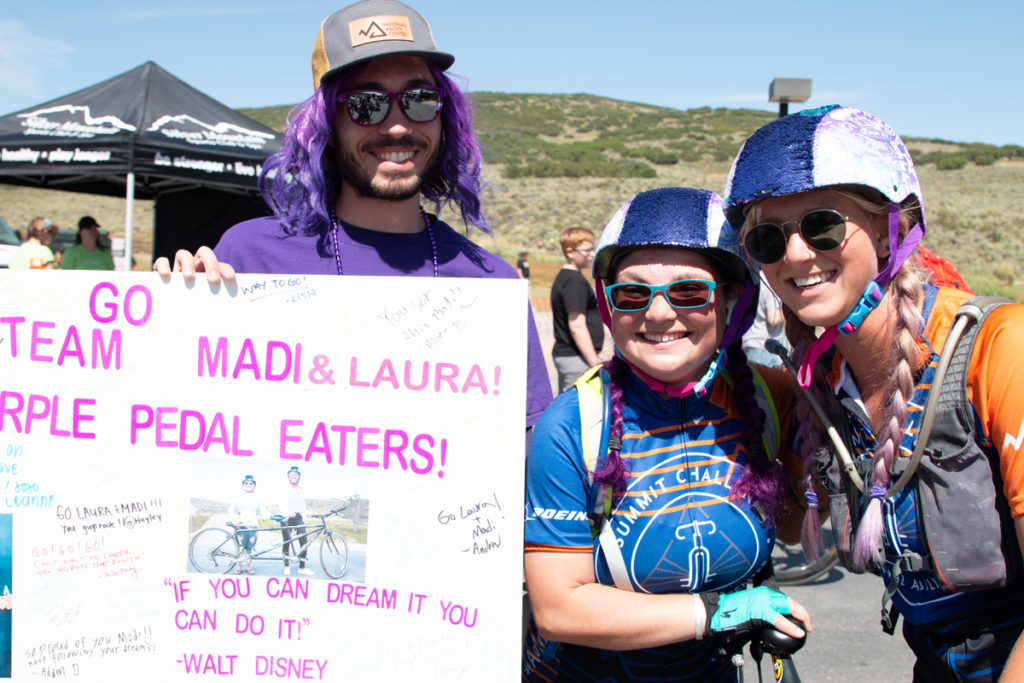By Madison Baumann – After months of training, my riding partner Laura Dusold and I were finally hitting the pavement for our 50-mile Summit Challenge tandem ride. We started early, just after the sun came up, hoping to beat the heat later in the day. It could have been our nerves – or the cold – but as we set out on the first 16 miles of our 50-mile route, hardly a word was spoken.

Since we started our ride ahead of most, we had the first portion of the course to ourselves along with a few hand-cyclists. who had also set out. Getting a jump start is an awesome option for any adaptive rider in the Summit Challenge who might require a bit more time or need to avoid the crowds of the main field.
You see, this wasn’t an ordinary ride, where chatting is more difficult than silence and you only factor in one person’s cadence, psychology, pacing and fatigue. I am a visually impaired athlete, so I ride a tandem with my cycling partner, Laura who acts as my eyes. We must pedal at the same time, rest at the same time and trust in one another as we take on this new challenge. If one of us bonks, we’re both in trouble.

The quiet roads made for easy pedaling and we soon found ourselves completing the 16-mile course and flying up the first major climb of the 50 mile route heading towards Kamas and flanked by the Jordanelle Reservoir. At this point, the fastest Summit Challenge 80-mile riders began making their way by us.
Sometimes being passed on a climb can be disheartening, but we were together, riding our tandem in matching jerseys and purple sequined helmet covers. Our team name was the Purple Pedal Eaters, hence all the purple. So, as riders passed, they cracked jokes about how if this were a downhill race, we’d be in the top five. Some even asked if there was room for a third on our bike. With each passing rider, our motivation grew, and we found it easy to hammer to the top of the climb.
The payoff? A great decent and cruise through the Kamas Valley. With Laura as my eyes, we easily navigated the downhills, laughing our way past cows, pastures and mountains. We even got to chat with a friend of ours who lives along the route and happened to be outside gardening as we rode by.
Then came Brown’s Canyon. Towards the end of the ride and at the hottest part of our day, this climb had lingered in the back of our minds throughout our months of training. A week before Summit Challenge, we tried this exact climb and we almost didn’t make it to the top. But this time, as we headed into the final push of the canyon, when Laura turned her head and said to me, “Madi, we’re going,” I knew we would make it to the summit.
It wasn’t long before we had left Brown’s Canyon in the background and found ourselves pedaling up Ability Way and into the finish line at the National Ability Center where our friends, coworkers and fellow riders cheered us along through the final mile, with music blaring!
We celebrated with burgers and a cold beer in the event village. The feeling of accomplishment was well worth it. Every training ride we almost canceled but went on anyway. We thankfully only encountered one fall during our months of training which helped me learn to trust Laura as my eyes, steering and tandem partner along the way even more. Next year, Laura and I have decided to up the ante and take on the Summit Challenge 80-mile route together. See you there in August 2020!
A benefit for the National Ability Center, the 12th annual Summit Challenge took place on Saturday, August 24, 2019 tracing many favorite road rides throughout the Park City, Kamas and Heber areas. This fully-supported ride offers several options including a 1-mile Discovery Loop, a 16-mile, 50-mile, 80-mile and 100-mile route. The event supports adaptive cycling, mountain bike and winter fat biking programs at the National Ability Center and also invites adaptive riders to participate in the Summit Challenge at no cost. The National Ability Centerprovides buddy riders, adaptive equipment like tandems, recumbent bikes and handcycles for adaptive cyclists in the Summit Challenge and offers ongoing NAC cycling programs. To learn more about the National Ability Center or becoming a volunteer, visit discovernac.org.
Editor’s Note: See part one of Riding Blind in the Late Summer 2019 issue of Cycling West, online at cyclingwest.com


















